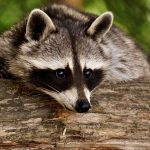 **Raccoons are protected by law. **
**Raccoons are protected by law. **
Description
Raccoons are “well-rounded,” plump, with reddish brown to grey fur. Adults are readily identified by alternating rings on the tail and characteristic black “mask.”
Distribution and Habitat
Raccoons are among the most widespread mammals in New York State. Raccoon populations are more dense in large cities than in the wild, but abundance varies in different parts of the state.
Behavior
Raccoons feed mainly at night. They eat fruit, nuts, berries, small animals, insects and on pet food, garbage, and garden crops. Female raccoons den in late winter. Litters are born in April and May.
Preventing Raccoons from Becoming a Nuisance
Raccoons are protected by law. No one may possess a raccoon without a license. Raccoons can become a nuisance if people unknowingly supply food or shelter for them. They can be attracted by food available in gardens, fish ponds, pet feeders, or garbage or by cavities that might offer shelter.
Here are some ways to prevent raccoons from becoming a nuisance:
- Do not leave pet food outside.
- Keep garbage bags in an entry-way or garage, and in a metal can.
- Block the openings raccoons are using to get into your attic, porch, or other location.
Websites
- Raccoon | National Geographic Kids
- Raccoon | Nocturnal Habits, Diet & Habitat
- Raccoons – Facts and Fancies
- Facts About Raccoons
- Raccoon Facts | Nature
- Raccoon Characteristics, Habitat & Lifespan
- 8 Facts About Raccoons: The Masked Mischief Makers
Videos
- All About Raccoons
- Raccoons for Kids | Homeschool Pop
- Raccoon Facts
- 15 Raccoon Facts That Will Blow Your Mind
- Everything You Need To Know About Raccoons Revealed!!!
- Debunking Myths about Raccoons
- How our actions are making raccoons smarter | Webby Award
- Fascinating Facts About Raccoons: Nature’s Ingenious …
Nuisance wildlife control persons licensed by New York State can be hired to deal with problem raccoons. Injured and “orphaned” raccoons should be left alone.
